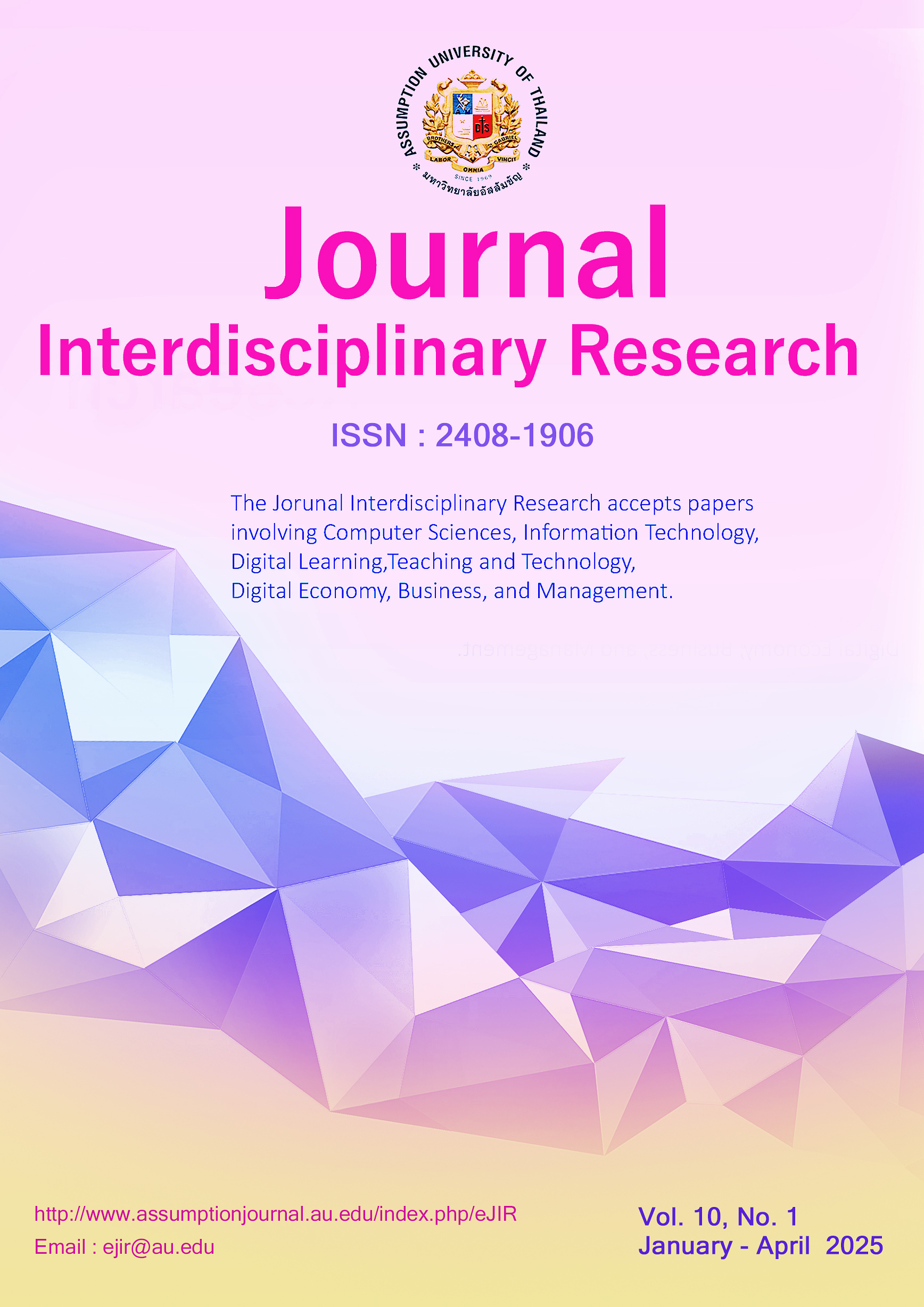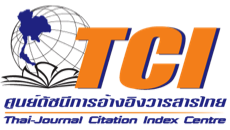The effectiveness of Music Hearing learning Outcomes of Higher Education Chinese Students
DOI:
https://doi.org/10.14456/au-ejir.2025.9Keywords:
Music Hearing training, Perception ability, Analysis ability, Reproduction ability, Learning attitudeAbstract
Purpose: This study focuses on the effectiveness of music majors using EarMaster software for music hearing training. The research objectives are as follows: 1. To determine whether using music learning software can improve the learning effect of hearing training; 2. Determine the difference in learning effect between the use of learning software and the use of traditional learning methods; 3. Determine students' learning attitude towards music hearing training by using music learning software. Research design, data, and methodology: A quasi-experiment and questionnaire survey were used. A total of 192 students were selected using the purposive sampling method. Music perception, analysis, and reproduction ability were tested in an eight-week quasi-experiment. Through a questionnaire survey, the perceived ease of use, perceived usefulness, and learning attitude towards the software use were investigated. Results: After the experimental intervention, the students in the experimental group improved significantly higher than the control group in music perception, analysis ability, reproduction ability, and total score on hearing test. Conclusions: The method of using music learning software significantly improves the hearing ability of music majors compared with the traditional learning method. The research has a specific value to the practice of listening and learning for music majors.
References
Apaydinli, K. (2020). Intelligent Tutoring Systems in Music Education. In A. Akin. (Ed.), Current studies in social science (pp. 13-17). Iksad Publishing House. https://doi.org/10.33422/2nd.icfte.2019.12.856.
Benites, D. A. M., Lalitte, P., & Eyharabide, V. (2023, April). Ear Training Applications in Music Education: Exploring Utilization, Effectiveness, and Adoption Factors in France. 6th Special Session on Educational Knowledge Management, 447-453. DOI: 10.5220/0012054200003470.
Butson, R., John, S., & Suazo, A. (2020). The Behaviour of Learning: Exploring Independent Study Practices of Undergraduate Health Science Students. Medical Science Educator, 30, 917-925. https://doi.org/10.1007/s40670-020-00974-5.
Chenette, T., Davis, S., & Kleppinger, S. V. (2022). A Critical Review of Current Aural Skill Materials and Pedagogical Practices. Journal of Music Theory Pedagogy, 36(1), 6.
China’s Ministry of Education. (2002, May). Notice of the Ministry of Education on Issuing the National Development Plan for School Art Education (2001-2010). http://www.moe.gov.cn/srcsite/A17/moe_794/moe_795/200205/t20020513_80694.html
Cronbach, L. J. (1951). Coefficient alpha and the internal structure of tests. psychometrika, 16(3), 297-334.
https://doi.org/10.1007/BF02310555
Danso, A., Rousi, R., & Thompson, M. (2021). Novel and experimental music technology use in the music classroom: learning performance, experience, and concentrated behavior. Human Technology, 17(1), 81-112.
https://doi.org/10.17011/ht/urn.202106223979.
Frasson, C., & Aimeur, E. (1998). Designing a multi-strategic intelligent tutoring system for industry training. Computers in industry, 37(2), 153-167. https://doi.org/10.1016/S0166-3615(98)00091-8.
Goncharova, M. S., & Gorbunova, I. B. (2020). Mobile Technologies in the Process of Teaching Music Theory. Propósitos Y Representaciones, 8(3), e705. https://doi.org/10.20511/pyr2020.v8nSPE3.705.
Hallam, S. (2010). 21st century conceptions of musical ability. Psychology of Music, 38(3), 308-330. https://doi.org/10.1177/0305735609351922
Henderson, S., & Yeow, J. (2012, January). iPad in education: A case study of iPad adoption and use in a primary school. the 45th Hawaii International Conference on System Sciences, 78-87. DOI: 10.1109/HICSS.2012.390.
Henson, R. A., & Wyke, M. A. (1982). The performance of professional musicians on the seashore measures musical talent: an unexpected finding. Cortex; a Journal Devoted to the Study of the Nervous System and Behavior, 18(1), 153-157.
https://doi.org/10.1016/s0010-9452(82)80026–9.
Hwang, Y. T., & Chu, C. N. (2018). The Design of Music Ear Training System in Building Mental Model with Image Stimulus Fading Strategy. Proceedings of the Fifth International Conference on Learning and Collaborative Technologies Part I, 127-135. https://doi.org/10.1007/978-3-319-91743-6_9.
Krejcie, R. V., & Morgan, D. W. (1970). Determining sample size for research activities. Educational and psychological measurement, 30(3), 607-610. https://doi.org/10.1177/001316447003000308
Liu, Y., & Liu, H. Y. (2012). Musical Ability Tests: Construct Extension and Analytical Transition. Advances in Psychological Science, 20(8), 1322-1328.
Macrides, E., & Angeli, C. (2018). Investigating TPCK through music focusing on effect, International Journal of Information and Learning Technology, 35(3), 181-198. https://doi.org/10.1108/IJILT-08-2017-0081.
Nikolić, I., & Kodela, S. (2020). Integral aspects of harmonic hearing in the process of sight-singing. Facta Universitatis, Series: Visual Arts and Music, 6(1), 49-60. https://doi.org/10.22190/10.22190/FUVAM2001049N
Parkita, E. (2021). Digital tools of music education. Central European Journal of Educational Research, 3(1), 60-66. https://doi.org/10.37441/CEJER/2021/3/1/9352
Pearce, M. T. (2023). Music Perception. Oxford Research Encyclopedia of Psychology. https://doi.org/10.1093/acrefore/9780190236557.013.890
Ruokonen, I., & Ruismäki, H. (2016). E-learning in music: A case study of learning group composing in a blended learning environment. Procedia-Social and Behavioral Sciences, 217, 109-115. https://doi.org/10.1016/j.sbspro.2016.02.039.
Revenko, V. (2021). Education and Music Culture in the Context of Web 2.0. International Journal of Emerging Technologies in Learning (iJET), 16(10), 96-107. https://www.learntechlib.org/p/220093
Schoen, M. (1928). Musical Talent and Its Measurement. The Musical Quarterly, 14(2), 255-282. http://www.jstor.org/stable/738365
Seashore, C. E. (1915). THE MEASUREMENT OF MUSICAL TALENT. The Musical Quarterly, 1(1), 129-148.
https://doi.org/10.1093/mq/i.1.129
Senaidi, S. R. A. (2019). A Triarchic Model on Student’s M-Learning Readiness in the Omani Context: A Structural Model View. International Journal of Computing, 8(6), 93-113.
Shen, S., & Wu, K. (2023). Solfeggio Teaching Method Based on MIDI Technology in the Background of Digital Music Teaching. International Journal of Web-Based Learning and Teaching Technologies (IJWLTT), 18(1), 1-18.
http://doi.org/10.4018/IJWLTT.331085.
Schüler, N. (2021). Modern approaches to teaching sight singing and ear training. Facta Universitatis, 6, 83-92.
https://doi.org/10.22190/FUVAM2002083S
Villar, S. M. (2015). Online Ear Training programs and systems: Advantages and Disadvantages. Sonograma Magazine.
Wang, Y. N. (2015). Study on solfeggio teaching under MIDI environment. CRC Press.
Downloads
Published
How to Cite
Issue
Section
License
Copyright (c) 2025 Yali Zhang

This work is licensed under a Creative Commons Attribution 4.0 International License.
A separate Copyright Form will be sent to authors whose paper is accepted for publication.






